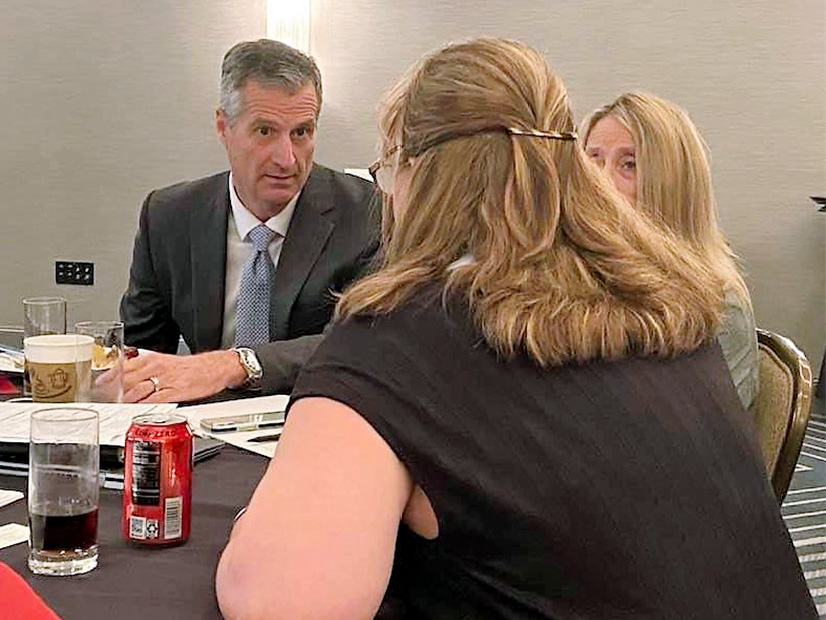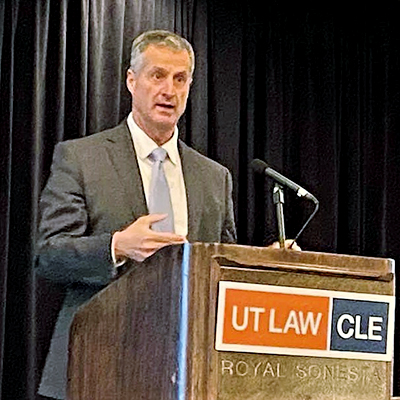
HOUSTON — Introduced as “clearly a man of courage and conviction to take this job at this time,” interim ERCOT CEO Brad Jones stepped up to the speaker’s podium and briefly rehashed February’s events that led to his leadership position with the Texas grid operator.
“The media said we weren’t prepared [for the February winter storm]. That’s not true,” he told an in-person and virtual audience Thursday during the University of Texas School of Law’s Gas and Power Institute.
Referencing a similar winter event that led to suggested weatherization recommendations, Jones added, “The generators were prepared, but to 2011 standards.”
But rather than revisit history, Jones made it clear his focus is on what lies ahead.
“The future of ERCOT depends on more than our response to the winter storm. It depends on our response to an extraordinarily fast-changing market,” he said.
 Brad Jones explains ERCOT’s future concerns to UT Law’s Gas and Power Institute. | © RTO Insider LLC
Brad Jones explains ERCOT’s future concerns to UT Law’s Gas and Power Institute. | © RTO Insider LLCSpeaking without notes, Jones said his 60-point roadmap to grid reliability, given home-page prominence on ERCOT’s website, addresses the grid operator’s concerns “today and tomorrow.” Twenty-nine of the roadmap’s items have been completed, with all but one of the remaining 31 listed as being “on track.” (Placing senior-level representatives from each member organization on the Technical Advisory Committee has been delayed until the new Board of Directors is fully in place.)
“The seeds of what we want to fix are in the [February] problems,” he said. “Weatherization has to improve. We can’t rely on 2011 standards. The weather is not waiting for the PUC to get [its] rules in place. ‘Winter is coming,’ as we’ve all heard.”
Jones said he has been contacted by generation owners who told him they are investing “tens of millions of dollars” in weatherizing their facilities. “They’re investing because they see where the weather is going and they need to get ahead of it,” he said.
ERCOT staff this November will begin inspecting nearly 300 generating units’ weatherization, concentrating on those responsible for the 80% of lost megawatts from the February storm. The grid operator is staffing up for the effort, which includes filing a report with the Public Utility Commission.
“I hope gas suppliers are moving forward, just like the generators,” Jones said. The FERC-NERC joint inquiry on the storm and other reports have all placed most of the blame for generation outages on the lack of natural gas supplies. Texas politicians have found the gas industry’s response to be lacking. (See Texas Senators Call for New RRC Weatherization Rules.)
Noting ERCOT’s interconnection queue is heavily weighted in favor of renewable energy projects, Jones said their “extraordinarily valuable” low prices need to be balanced with more reliable generation. He brought up the RACE acronym he often uses with the public: reliable, affordable, clean electricity.
“For too long, it’s been CARE. We’ve got to put the R back in front,” Jones said. “One of the things the state has failed to do over the last 20 years is to put reliability first.”
Jones said ERCOT would like to see “stout” firm fuel contracts, dual-fuel capabilities and underground storage to ensure thermal plants have a reliable fuel supply. Citing rising gas prices, he also said he wants to separate generation from relying on natural gas, should the power equation’s gas side again fail during extreme weather.
“We want to ensure there’s language in the contracts to firm them up as much as possible and to give them some teeth to ensure reliable delivery,” Jones said.
Asked whether a capacity market would have resolved ERCOT’s problems during the winter storm, Jones said he is a fan of capacity markets and that they work “very well.”
“The problem is, it takes so much time to tune the rules and change things to drive certain outcomes,” he said. He used PJM’s capacity market as an example of a market that “drives the type of reliability we need” with its firm-fuel requirements.
“It’s also true that we can build those same tools outside of a capacity market,” Jones said. “It’s not necessarily true that a capacity market would have saved us. We had the capacity; it just didn’t operate.”
A capacity market would have helped in the billions of market charges assessed to participants in the two days after the storm subsided, Jones said. During that time, the PUC kept market prices at $9,000/kWh to encourage generation to stay online. He said capacity markets typically have $1,000 offer caps because capacity resources are paid on an annual basis.
“The financial storm would have been little more than 1/10 of what actually occurred,” Jones said.
The scars from February still remain. Jones said during a recent call with North Texas mayors, he was asked about the likelihood of another winter storm in 2022. Calling February’s a one-in-130 year event, he said one could assume a 1% chance of a similar destructive storm. However, weather forecasters have also said there’s a higher likelihood of another winter event the year after another one, Jones said.
“So not a 2021, but perhaps a 2011 storm,” he said, placing the chances in the 10-15% range. “We have to be prepared for something like that … and we are getting ready. I feel very confident we will be ready.”
Uncertainty for ERCOT Board, Market
Two energy lawyers both expressed uncertainty about changes to ERCOT’s governance structure and market design.
Meghan Elaine Griffiths, an attorney with Jackson Walker, said a questioner’s guess “is as good as mine” when queried about how the political appointees to the ERCOT board will affect the market and stakeholder process. Under new legislation passed earlier this year, the board’s structure of unaffiliated directors and market segment representatives has been replaced by a selection committee’s appointees, with the committee itself selected by the state’s political leadership. (See 2 New ERCOT Directors Named, Replacing Current Board.)
“One of the benefits of having market stakeholders on the board is they have a deep knowledge of the business and a deep knowledge of the protocols as they’re developed,” Griffiths said. “I think there’s a very steep learning curve for our new ERCOT board members. We’ll see how that plays out over time.”
Already, one media report has highlighted board Chair Paul Foster’s tie to Republicans. According to The Dallas Morning News, Foster has since June donated $1.775 million to Gov. Greg Abbott’s campaign committee.
Michael Nasi, a partner with Jackson Walker, shared a quote on market design from PUC Chair Peter Lake before the State Legislature: “‘I want to reassure you that we are not tweaking on the edges or making marginal changes. We are taking a blank-slate approach for a full overhaul and redesign of this market to drive reliability. Full stop.’”
“This market has been cited as the envy of many and potentially modeled in many places in this country and around the world,” Nasi said, referring to pre-February perspectives. “And then to have Chairman Lake say we’re going to fundamentally redesign this … I welcome the change, but how does it get done? It will be hard work, but it’s doable. ERCOT can still be a model for others.”


